Body Mechanics: What They Are and Why They Matter
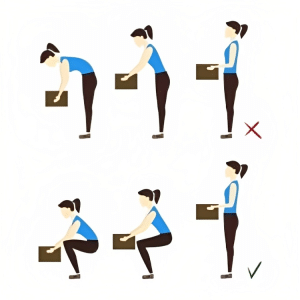
Body mechanics are the way we move during our daily activities. They involve the coordinated effort of muscles, bones, and the nervous system to maintain balance, posture, and alignment. Proper body mechanics can help us avoid injury and muscle fatigue, as well as improve our health and well-being.
In this blog post, we will explore the following topics:
– What are the elements of body mechanics?
– What are the risk factors for musculoskeletal injuries (MSIs)?
– How can we practice proper body mechanics in different situations?
– What are some tips and resources to improve our body mechanics?
Elements of Body Mechanics
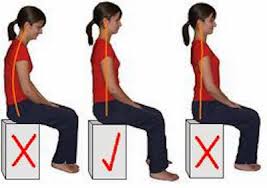
Body movement requires three basic elements: body alignment, balance, and coordinated movement.
– Body alignment refers to the position of body parts in relation to each other. When the body is well aligned, whether standing, sitting, or lying, the strain on the joints, muscles, tendons, and ligaments is minimized. Correct alignment also contributes to body balance and optimal body function.
– Balance refers to the ability to maintain a stable position and prevent falls. Balance depends on several factors, such as the center of gravity, the base of support, and the line of gravity. The center of gravity is the point where the weight of an object or person is evenly distributed. The base of support is the area on which an object or person rests. The line of gravity is an imaginary vertical line that passes through the center of gravity. To achieve balance, the center of gravity should be close to the base of support and within the line of gravity.
– Coordinated movement refers to the smooth and efficient use of muscles and joints to perform an activity. Coordinated movement requires neurological integration and muscular strength and flexibility. It also involves planning and executing movements with awareness and control.
Risk Factors for Musculoskeletal Injuries
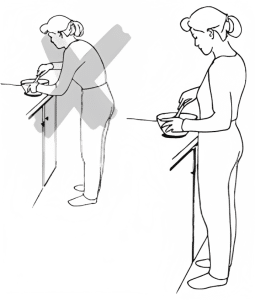
A musculoskeletal injury (MSI) is an injury or disorder of the muscles, tendons, ligaments, joints, nerves, blood vessels, or related soft tissue. MSIs are the most common health hazard for healthcare providers and other workers who perform manual tasks. MSIs can cause pain, disability, reduced productivity, and decreased quality of life.
According to WorkSafeBC, there are two main types of risk factors that contribute to an MSI: ergonomic risk factors and individual risk factors.
– Ergonomic risk factors are related to the physical demands and environmental conditions of work. They include repetitive or sustained awkward postures, repetition, forceful exertion, contact stress, vibration, and temperature extremes.
– Individual risk factors are related to the personal characteristics and habits of workers. They include poor work practices, poor overall health (smoking, drinking alcohol, obesity), poor rest and recovery, poor fitness, hydration, and nutrition.
The table below summarizes some examples of ergonomic and individual risk factors for MSIs.
| Factor | Example |
|---|---|
| Ergonomic risk factor | Lifting a heavy patient from a low bed |
| Individual risk factor | Not using a mechanical lift or asking for help |
When workers are exposed to ergonomic risk factors, they become fatigued and risk musculoskeletal imbalance. Additional exposure related to individual risk factors puts workers at increased risk for an MSI.
How to Practice Proper Body Mechanics in Different Situations
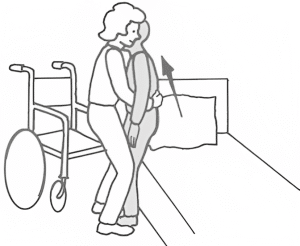
Practicing proper body mechanics can help prevent or reduce the risk of MSIs. Proper body mechanics involves following some general guidelines as well as adapting them to specific situations.
Some general guidelines for proper body mechanics are:
– Bend at your hips and knees instead of your waist. This helps you maintain your balance by dividing your weight evenly between your upper and lower body.
– Spread your feet apart to create a foundation of support. This helps you maintain your balance from side to side.
– Keep your back straight and avoid twisting or bending at your waist. This helps you protect your spine and avoid injury.
– Lift objects using your arm and leg muscles. Hold objects close to your body at your waist level. This helps you reduce the strain on your back and use less energy.
– Push rather than pull objects. It is easier to push than to pull.
– Ask for help or use an available device for assistance. Assistive or mechanical devices help decrease your risk for injury.
Some specific situations where proper body mechanics are important are:
– When you stand: Keep your feet flat on the floor about 12 inches (30 cm) apart. Do not lock your knees. Keep your shoulders down, chest out, and back straight.
– When you sit: Sit with your back straight and place extra support behind your lower back. Get up and change positions often if you sit for long periods of time. Ask about exercises to stretch your neck and shoulders. Adjust your computer so the top of the monitor is at the same level as your eyes. Use a paper holder so that the document is at the same level as the computer screen. Use a headset if you use the telephone often.
– When you sleep: Choose a mattress, pillow, and position that support your spine and allows you to relax. Avoid sleeping on your stomach, as this can cause neck and back pain. Try to sleep on your side with a pillow between your knees or on your back with a pillow under your knees.
Tips and Resources to Improve Your Body Mechanics
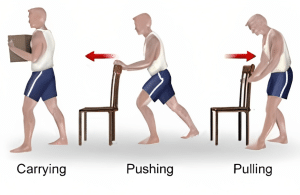
Improving your body mechanics is not only beneficial for your health and safety but also for your performance and satisfaction at work and in life. Here are some tips and resources to help you improve your body mechanics:
– Seek professional advice from a physiotherapist, occupational therapist, or ergonomist if you have any questions or concerns about your body mechanics or MSIs.
– Perform regular exercises to strengthen and stretch your muscles, improve your posture, and increase your flexibility and mobility. You can find some examples of exercises for different body parts here.
– Practice mindfulness and awareness of your body and movements. Pay attention to how you feel and adjust your posture and movements accordingly. Avoid habits that can compromise your body mechanics, such as slouching, crossing your legs, or holding the phone between your ear and shoulder.
– Take frequent breaks and change positions throughout the day. This can help prevent muscle fatigue and stiffness, as well as improve your blood circulation and energy levels.
We hope this blog post has helped you understand what body mechanics are and why they matter. Remember, proper body mechanics can help you avoid injury and muscle fatigue, as well as improve your health and well-being. So, start practicing proper body mechanics today and enjoy the benefits!
References
(1) 3.2 Body Mechanics – Clinical Procedures for Safer Patient Care.
(2) Proper Body Mechanics – What You Need to Know – Drugs.com.
(3) Injury Prevention and Body Mechanics – Physiopedia.
(4) The Importance of Proper Body Mechanics – Keeping Your Spine Healthy.
FAQs
Q: What are body mechanics?
A: Body mechanics refers to the way we move and position our bodies to perform tasks efficiently and safely.
Q: Why is good body mechanics important?
A: Good body mechanics help prevent injuries, reduce strain on muscles and joints, and promote proper alignment and posture.
Q: What are some common principles of good body mechanics?
A: Some common principles include maintaining a stable base of support, using the larger muscle groups, avoiding excessive bending and twisting, and maintaining proper posture.
Q: How can I maintain a stable base of support?
A: Keep your feet shoulder-width apart, with one foot slightly in front of the other, and distribute your weight evenly between both feet.
Q: Which muscle groups should I use when lifting or carrying objects?
A: Use the muscles in your legs and hips (such as the quadriceps and glutes) to generate power and support the load, rather than relying solely on your back muscles.
Q: How can I avoid excessive bending and twisting?
A: Instead of bending at the waist, use your knees and hips to squat down and maintain a straight back. When turning, pivot your feet instead of twisting your spine.
Q: What is proper posture and how can I maintain it?
A: Proper posture involves aligning the ears, shoulders, hips, and ankles in a straight line. To maintain it, be mindful of your posture throughout the day and use supportive chairs and ergonomic equipment if needed.
Q: Are there any specific guidelines for sitting at a desk?
A: Yes, it’s important to sit with your feet flat on the floor, knees bent at a 90-degree angle, back supported by the chair, and computer screen at eye level to reduce strain on your neck and back.
Q: How can I prevent back pain when standing for long periods?
A: Stand with one foot slightly in front of the other, shift your weight between both feet and use a footrest to reduce stress on your lower back. Take breaks to sit or stretch periodically.
Q: Is it necessary to warm up before physical activity?
A: Yes, warming up before physical activity increases blood flow to the muscles, improves flexibility, and reduces the risk of injury.
